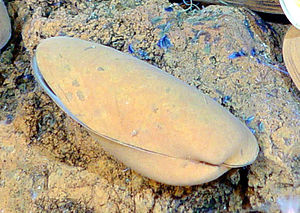Bathymodiolus
aus Wikipedia, der freien Enzyklopädie
| Bathymodiolus | ||||||||||||
|---|---|---|---|---|---|---|---|---|---|---|---|---|

Abbildung einer Tiefsee-Miesmuschel (Bathymodiolus spec.) | ||||||||||||
| Systematik | ||||||||||||
| ||||||||||||
| Wissenschaftlicher Name | ||||||||||||
| Bathymodiolus | ||||||||||||
| Kenk & Wilson, 1985 |
Bathymodiolus ist eine Gattung von „Tiefsee-Miesmuscheln“ aus der Familie der Miesmuscheln (Mytilidae); es ist die Typusgattung der Unterfamilie Bathymodiolinae. Die Arten dieser Gattung züchten in den Kiemen bakterielle chemoautotrophe Symbionten.




Merkmale
[Bearbeiten | Quelltext bearbeiten]Das längliche, gleichklappige Gehäuse ist glatt mit einem gebogenen oder gewinkelten Dorsalrand. Der Ventralrand ist bei kleineren Exemplaren annähernd gerade, bei größeren Exemplaren auch leicht konkav gebogen. Die Gehäuse werden recht groß; bis zu 30 cm lang. Die Schale ist fest, die Oberfläche weitgehend glatt mit einem glatten oder auch haarigen Periostracum. Der Wirbel sitzt nahe am gerundeten Vorderende. Das Schloss ist zahnlos. Der hintere Retraktormuskel teilt sich in zwei Bündel. Der Sipho, über den die Muschel Altwasser abgibt, ist kurz und ausstreckbar mit einem inneren Diaphragma.
Geographische Verbreitung und Lebensraum
[Bearbeiten | Quelltext bearbeiten]Bathymodiolus-Arten kommen an (kalten) Methanquellen und hydrothermalen Quellen (Schwarzen Rauchern) in Wassertiefen zwischen 630 und 3500 Metern vor, wo sie ausgedehnte Muschelfelder um die Quellen herum bilden können. Die in besonderen Zellen (Bacteriocyten) im Kiemenepithel der Tiefsee-Miesmuscheln lebenden Schwefel- und/oder Methan-Bakterien[1] ernähren sich vom Methan bzw. Schwefelwasserstoff, das aus dem Meerwasser aufgenommen wird.
Darüber hinaus wurden diverse Bathymodiolus-Arten an Walfällen nachgewiesen.[2]
Taxonomie und Systematik
[Bearbeiten | Quelltext bearbeiten]Das Taxon wurde 1985 durch Vida Carmen Kenk und Barry Wilson erstmals beschrieben; zur Typusart bestimmten sie die ebenfalls neue Art Bathymodiolus thermophilus[3] Im März 2023 akzeptierte das World Register of Marine Species folgende Arten[4]:
- Gattung Bathymodiolus Kenk & B. R. Wilson, 1985
- Bathymodiolus aduloides Hashimoto & Okutani, 1994
- † Bathymodiolus akanudaensis (Kuroda, 1931)
- Bathymodiolus antarcticus S. B. Johnson & Vrijenhoek, 2013
- Bathymodiolus anteumbonatus Cosel & Janssen, 2008
- Bathymodiolus azoricus Cosel & Comtet, 1999
- Bathymodiolus boomerang Cosel & Olu, 1998
- Bathymodiolus brevior Cosel, Métivier & Hashimoto, 1994
- Bathymodiolus brooksi Gustafson, Turner, Lutz & Vrijenhoek, 1998
- Bathymodiolus earlougheri McCowin, Feehery & Rouse, 2020
- Bathymodiolus edisonensis Cosel & Janssen, 2008
- Bathymodiolus elongatus Cosel, Métivier & Hashimoto, 1994
- Bathymodiolus heckerae Turner, Gustafson, Lutz & Vrijenhoek, 1998
- †Bathymodiolus heretaunga Saether, Little, K. A. Campbell, B. A. Marshall, M. Collins & Alfaro, 2010 (Miozän, Neogen)
- Bathymodiolus hirtus Okutani, Fujikura & Sasaki, 2004
- †Bathymodiolus inouei Amano & Jenkins, 2011 (Oberes Oligozän)[5]
- Bathymodiolus japonicus Hashimoto & Okutani, 1994
- †Bathymodiolus labayugensis Kiel, Fernando, Magtoto & Kase, 2022
- Bathymodiolus manusensis Hashimoto & Furuta, 2007
- Bathymodiolus marisindicus Hashimoto, 2001
- Bathymodiolus mauritanicus Cosel, 2002
- Bathymodiolus nancyschneiderae McCowin, Feehery & Rouse, 2020
- †Bathymodiolus palmarensis (Kiel, Campbell & Gaillard, 2010)
- Bathymodiolus puteoserpentis Cosel, Métivier & Hashimoto, 1994
- †Bathymodiolus satsopensis Kiel & Amano, 2013 (Oberes Oligozän, Paläogen)[5]
- Bathymodiolus securiformis Okutani, Fujikura & Sasaki, 2004
- Bathymodiolus septemdierum Hashimoto & Okutani, 1994
- Bathymodiolus thermophilus (Kenk & Wilson, 1985)
- †Bathymodiolus willapaensis (Squires & Goedert, 1991)
Literatur
[Bearbeiten | Quelltext bearbeiten]- S. Peter Dance, Rudo von Cosel (Bearb. der deutschen Ausgabe): Das große Buch der Meeresmuscheln. 304 S., Verlag Eugen Ulmer, Stuttgart, 1977, ISBN 3-8001-7000-0 (S. 227).
- Rudolf Kilias: Lexikon Marine Muscheln und Schnecken. 2. Aufl., Verlag Eugen Ulmer, Stuttgart 1997, ISBN 3-8001-7332-8 (S. 206).
- Kristian P. Saether, Crispin T. S. Little, Kathleen A. Campbell, Bruce A. Marshall, Mike Collins, Andrea C. Alfaro: New fossil mussels (Bivalvia: Mytilidae) from Miocene hydrocarbon seep deposits, North Island, New Zealand, with general remarks on vent and seep mussels. In: Zootaxa Nr. 2577, 2010, S. 1–45; PDF (englisch).
- Jun-Ichi Miyazaki, Leonardo de Oliveira Martins, Yuko Fujita, Hiroto Matsumoto, Yoshihiro Fujiwara: Evolutionary Process of Deep-Sea Bathymodiolus Mussels. In: PLoS ONE, Band 5, Nr. 4, 2010, S. e10363; doi:10.1371/journal.pone.0010363 (englisch).
- Justine Thubaut, Nicolas Puillandre, Baptiste Faure, Corinne Cruaud, Sarah Samadi: The contrasted evolutionary fates of deep-sea chemosynthetic mussels (Bivalvia, Bathymodiolinae). In: Ecology and Evolution, Band 3, Nr. 14, 2013, S. 4748–4766; doi:10.1002/ece3.749 (englisch).
- Miguel Ángel González Porras, Adrien Assié, Målin Tietjen, Marlene Violette, Manuel Kleiner, Harald Gruber-Vodicka, Nicole Dubilier, Nikolaus Leisch: An intranuclear bacterial parasite of deep-sea mussels expresses apoptosis inhibitors acquired from its host. In: Nature Microbiology; 6. September 2024; doi:10.1038/s41564-024-01808-5 (englisch). Dazu:
- Übernahme der Schaltzentrale der Zelle: Zellkernparasiten in Tiefseemuscheln. Pressemeldung des Max-Planck-Instituts für Marine Mikrobiologie (Bremen) vom 6. September 2024.
- NCBI Txonomy Browser: "Candidatus Endonucleobacter bathymodioli" Zielinski et al. 2009; intranuclear bacterium of Bathymodiolus spp. (Gammaproteobacteria; Oceanospirillales).
Einzelnachweise
[Bearbeiten | Quelltext bearbeiten]- ↑ Annelie Wendeberg, Frank U. Zielinski, Christian Borowski, Nicole Dubilier: Expression patterns of mRNAs for methanotrophy and thiotrophy in symbionts of the hydrothermal vent mussel Bathymodiolus puteoserpentis. The ISME Journal, 6: 104–112, 2012 doi:10.1038/ismej.2011.81
- ↑ Ecology of Whale Falls at the Deep-Sea Floor von C. R. Smith und A. R. Baco (2003) Annual Review of Oceanography and Marine Biology, abgerufen am 25. März 2023
- ↑ Vida Carmen Kenk, Barry R. Wilson: Bathymodiolus, a new Galapagos rift mussel. Malacologia, 26(1-2): 253-271, 1985 Online bei archive.org (S. 255)
- ↑ WoRMS taxon details. Bathymodiolus Kenk & B. R. Wilson, 1985 World Register of Marine Species, abgerufen am 25. März 20232
- ↑ a b Steffen Kiel, Kazutaka Amano: The Earliest Bathymodiolin Mussels: An Evaluation of Eocene and Oligocene Taxa from Deep-Sea Methane Seep Deposits in Western Washington State, USA. Journal of Paleontology, 87(4):589-602, 2013 doi:10.1666/12-135
Weblinks
[Bearbeiten | Quelltext bearbeiten]Text is available under the CC BY-SA 4.0 license; additional terms may apply.
Images, videos and audio are available under their respective licenses.
